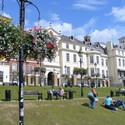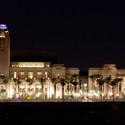.jpg?1429206021&format=webp&width=640&height=429)
For the best part of a century, architectural discussion has been dominated by modernism and other related forms of futurism and functionalism. For some, this constant invocation of the radically new has begun to look quite tired. In the 1980s looking backwards for inspiration famously brought us the adaptive and populist postmodernists, but also emerging at this time was New Classical architecture, which completely rejected any continuity with modernism and returned instead to traditional rules. In the years since, New Classical architecture has evolved into a resurgence of pre-modern forms, with the term also incorporating designs that would never have been considered "classical" in the first place - including Gothic and non-western historicist styles. We've rounded up some of the most surprising, interesting - even high-tech - examples of New Classical architecture after the break.
Whitman College, Princeton, 2002
.jpg?1429206011)
Funded by eBay CEO Meg Whitman, Demetri Porphyrios's College building was chosen to continue the High Gothic style of Princeton's late 19th century expansion as it became the university it is today.The college uses a variety of different stylings within the complex, forming a community of buildings that is meant to reflect the learning community within the University. The college is unified by the common language of neo-Gothic, a unity that advocates of New Classical architecture would argue is harder to achieve in contemporary styles.
.jpg?1429206001)
Oxford Center for Islamic Studies, Oxford, 2013

Proving that New Classicism doesn't haven't to be backwards-looking, Abdel-Wahed El-Wakil's Center for Islamic Studies combines classical Islamic forms with the traditional style of Oxford Colleges, reflecting the common heritage of Islamic scholarship and Oxford University. The Islamic vernacular and craftsmanship placed into a western classical context in such a harmonious fashion is a statement of Islam's place in the modern UK and is an example of the way classical forms and rules can be used to create something genuinely progressive.

Schermerhorn Symphony Center, Nashville, 2006
.jpg?1429411944)
Nashville's status as the 'Athens of the South' was only confirmed by the addition of David M. Schwarz's Symphony Center, a technologically advanced concert hall with careful acoustic design and great flexibility granted by the easily reconfigurable main hall, which enables raked seating to be converted to a flat floor, allowing for many uses of the space. The long history of classical form and Greek imitation in Nashville does soften the incongruity of the hall, but heavy reliance on imitating other concert halls from Vienna to Amsterdam does miss out on the sense of place that the Schermerhorn was intended to evoke.
.jpg?1429206032)
Smith Center for the Performing Arts, Las Vegas, 2009

The first performing arts center in the US to be rated as Silver by the US Green Building Council, David M. Schwarz chose to create an innovatively sustainable building that echoed Nevada's Hoover Dam as a way of further echoing Las Vegas' long history of pastiche and imitation. Like his earlier Symphony Center, the clean forms and ornate decoration of the center are wrapped around advanced acoustic engineering, energy efficient fittings and recycled materials that make this building at once reflective of Las Vegas' grand history and showing off a sustainable future.

Richmond Riverside, London, 1987

The ever controversial Quinlan Terry was one of the first practitioners of New Classical architecture as a distinct movement in the 1980s, and has become a favourite of the establishment of the UK. Both criticised and praised for his tendency to take the rules of classicism lightly, Richmond Riverside is a playful development and 'restoration' of remaining old buildings that uses Terry's lightness to create an extremely flexible set of buildings that lean heavily into pastiche. That said, the depth of knowledge about traditional methods that allows Terry to break all these rules also gives him a tremendous understanding of material and scale, creating a dense and economical development that contemporary styles might have struggled with.

Edificio Artklass, Bilbao, 2011

Since the Guggenheim Museum sparked off Bilbao's much documented architectural surge, the city has been dotted with work from the great and good of avant-garde architecture, but this block from Robert Krier and Marc Breitman is an attempt to echo the traditional style of the Ensanche district of Bilbao, resulting in a more local flavor without sacrificing modernity. The 180 apartments in the six façade building are designed to give the inhabitants a greater sense of place than contemporary styled buildings.




.jpg?1429206001)


.jpg?1429206021)